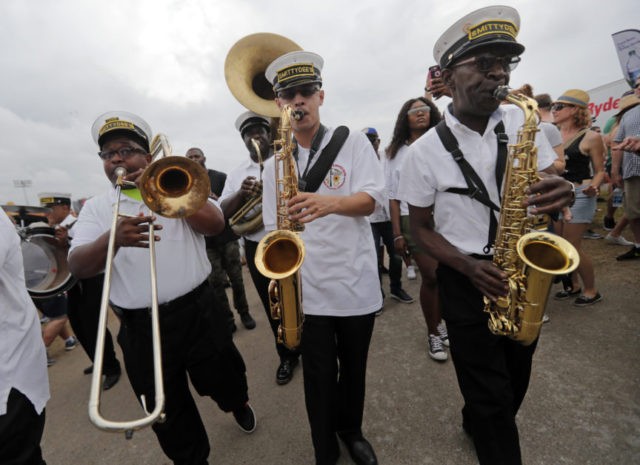NEW ORLEANS (AP) — A Canadian Celtic band with Acadian roots and two of the grand masters of traditional jazz kicked off the heritage interview stage Saturday at the New Orleans Jazz and Heritage Festival.
Rain helped fill seats in the grandstand building at the horse racing track where the festival is held.
The Allison Miner Music Heritage Stage, which features five interviews most days, is one of two stages where people can get a second chance to hear a performer or group. The other is the Cultural Exchange Pavilion near the center of the infield, which centers on a different theme each year. This year’s theme is New Orleans’ tricentennial.
The heritage stage’s first interview was with The East Pointers: Tim and Koady Chaisson, fiddler and banjoist cousins from Charlottetown in Prince Edward Island, and guitarist Jake Charron from Ontario. They started with a set of original reels called “Party Wavin.'”
“We do our own take on traditional tunes. That’s the whole point of the band,” said Tim Chaisson. Those takes won their first album Canada’s Juno Award for the year’s best traditional album, and got their second one nominated.
The cousins have been playing together since childhood, and their grandfather started a fiddling festival which they began running two years ago.
“It goes back seven generations, the fiddling,” Koady Chaisson said.
Audience members included Daniel Vance, 33, of the New Orleans area. “I play with the New Orleans Strathspey and Reel Society. I like to listen to and play the music,” he said.
Jazz clarinetist Dr. Michael White and trumpeter Gregg Stafford talked about the early days of jazz in New Orleans — and their relatives who were playing then. They also talked about how they themselves started out in music. It wasn’t either man’s early aspiration.
“I fell into music,” Stafford said. He said he began playing trumpet because the high-school elective he’d chosen — industrial arts — was full. “I thought I was taking music just that one year, and I’d get back into industrial arts. I enjoyed it so much I stayed,” he said.
White said, “I never aspired to become a musician. I heard all the stereotypes. I wanted to eat; I wanted a home.”
So rather than major in music he took and taught Spanish. But, he said, something kept telling him music was what he was supposed to do, no matter how often he told himself otherwise.
Susan Rosenthal of Durham, North Carolina, said rain and curiosity about cornetist Buddy Bolden, the subject of a movie she’d seen during the Prospect.4 art show, drew her in. As it turned out, Bolden wasn’t mentioned. Attorney Kathy Moss of New Orleans said, “I like to listen to a lot of jazz but I’m not very educated about it. I want to discover what’s behind the music I love so much.”
Second-generation zydeco musician Curley Taylor, Mardi Gras Indian chief Victor Harris and blues rock guitarist Walter Trout also were on the interview stage.
The Cultural Exchange Pavilion’s goal “is to highlight some of the cultural ancestors of New Orleans and make ties with the rest of the world,” coordinator Valérie Guillet said.
Saturday’s representatives from the wide variety of cultures that contributed to New Orleans are local Latin band Julio y Cesar; Kermit Ruffins’ commissioned tribute to trumpeter Louis Armstrong; Jupiter & Okwess, from the Republic of Congo; the East Pointers; and Leyla McCalla, a Haitian-American singer who lists much of the city’s musical gumbo as among styles that have influenced her.
This year’s displays include a timeline of New Orleans history and four altars honoring different people, traditions and groups. An elaborate display of decorative breads, pastries and other foods recreates the annual tradition of honoring St. Joseph, patron saint of Sicily, on March 19. The Hispanic community that has grown immensely since Hurricane Katrina in 2005 is honored with a Day of the Dead altar. A Marie Laveau altar marks voodoo and other Haitian influences. The fourth altar honors Jean San Malo, who led villages of escaped slaves known as maroons outside New Orleans during Spanish colonial days.

COMMENTS
Please let us know if you're having issues with commenting.